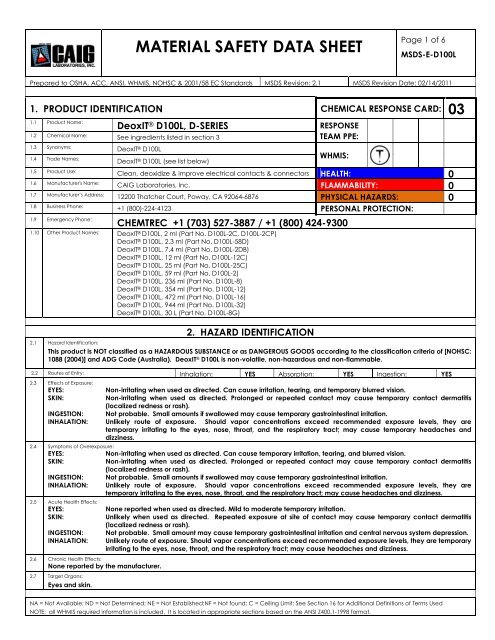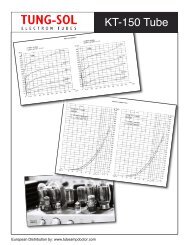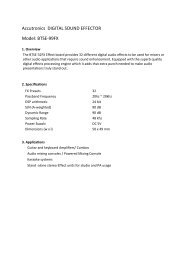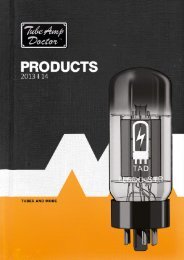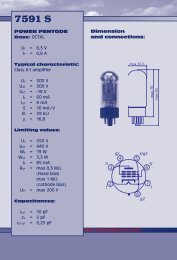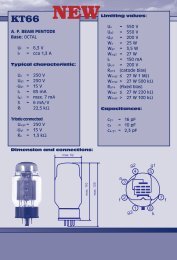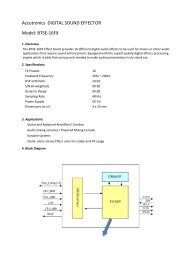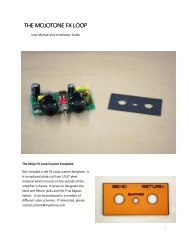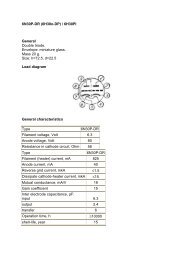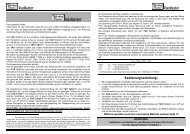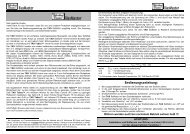Material Safety Data Sheet(MSDS)
Material Safety Data Sheet(MSDS)
Material Safety Data Sheet(MSDS)
Create successful ePaper yourself
Turn your PDF publications into a flip-book with our unique Google optimized e-Paper software.
MATERIAL SAFETY DATA SHEET<br />
Page 1 of 6<br />
<strong>MSDS</strong>-E-D100L<br />
Prepared to OSHA, ACC, ANSI, WHMIS, NOHSC & 2001/58 EC Standards <strong>MSDS</strong> Revision: 2.1 <strong>MSDS</strong> Revision Date: 02/14/2011<br />
1. PRODUCT IDENTIFICATION CHEMICAL RESPONSE CARD: 03<br />
1.1 Product Name:<br />
DeoxIT ® D100L, D-SERIES<br />
1.2 Chemical Name:<br />
See ingredients listed in section 3<br />
1.3 Synonyms:<br />
DeoxIT ® D100L<br />
1.4 Trade Names:<br />
DeoxIT ® D100L (see list below)<br />
RESPONSE<br />
TEAM PPE:<br />
WHMIS:<br />
1.5 Product Use:<br />
Clean, deoxidize & improve electrical contacts & connectors HEALTH: 0<br />
1.6 Manufacturer's Name:<br />
CAIG Laboratories, Inc. FLAMMABILITY: 0<br />
1.7 Manufacturer’s Address:<br />
12200 Thatcher Court, Poway, CA 92064-6876 PHYSICAL HAZARDS: 0<br />
1.8 Business Phone:<br />
+1 (800)-224-4123 PERSONAL PROTECTION:<br />
1.9 Emergency Phone:<br />
CHEMTREC +1 (703) 527-3887 / +1 (800) 424-9300<br />
1.10 Other Product Names: DeoxIT ® D100L, 2 ml (Part No. D100L-2C, D100L-2CP)<br />
DeoxIT ® D100L, 2.3 ml (Part No. D100L-58D)<br />
DeoxIT ® D100L, 7.4 ml (Part No. D100L-2DB)<br />
DeoxIT ® D100L, 12 ml (Part No. D100L-12C)<br />
DeoxIT ® D100L, 25 ml (Part No. D100L-25C)<br />
DeoxIT ® D100L, 59 ml (Part No. D100L-2)<br />
DeoxIT ® D100L, 236 ml (Part No. D100L-8)<br />
DeoxIT ® D100L, 354 ml (Part No. D100L-12)<br />
DeoxIT ® D100L, 472 ml (Part No. D100L-16)<br />
DeoxIT ® D100L, 944 ml (Part No. D100L-32)<br />
DeoxIT ® D100L, 30 L (Part No. D100L-8G)<br />
2.1 Hazard Identification:<br />
2. HAZARD IDENTIFICATION<br />
This product is NOT classified as a HAZARDOUS SUBSTANCE or as DANGEROUS GOODS according to the classification criteria of [NOHSC:<br />
1088 (2004)] and ADG Code (Australia). DeoxIT ® D100L is non-volatile, non-hazardous and non-flammable.<br />
2.2 Routes of Entry: Inhalation: YES Absorption: YES Ingestion: YES<br />
2.3 Effects of Exposure:<br />
EYES:<br />
Non-irritating when used as directed. Can cause irritation, tearing, and temporary blurred vision.<br />
SKIN:<br />
Non-irritating when used as directed. Prolonged or repeated contact may cause temporary contact dermatitis<br />
(localized redness or rash).<br />
INGESTION: Not probable. Small amounts if swallowed may cause temporary gastrointestinal irritation.<br />
INHALATION: Unlikely route of exposure. Should vapor concentrations exceed recommended exposure levels, they are<br />
temporary irritating to the eyes, nose, throat, and the respiratory tract; may cause temporary headaches and<br />
dizziness.<br />
2.4 Symptoms of Overexposure:<br />
EYES:<br />
Non-irritating when used as directed. Can cause temporary irritation, tearing, and blurred vision.<br />
SKIN:<br />
Non-irritating when used as directed. Prolonged or repeated contact may cause temporary contact dermatitis<br />
(localized redness or rash).<br />
INGESTION: Not probable. Small amounts if swallowed may cause temporary gastrointestinal irritation.<br />
INHALATION: Unlikely route of exposure. Should vapor concentrations exceed recommended exposure levels, they are<br />
temporary irritating to the eyes, nose, throat, and the respiratory tract; may cause headaches and dizziness.<br />
2.5 Acute Health Effects:<br />
EYES:<br />
SKIN:<br />
INGESTION:<br />
INHALATION:<br />
2.6 Chronic Health Effects:<br />
None reported by the manufacturer.<br />
2.7 Target Organs:<br />
Eyes and skin.<br />
None reported when used as directed. Mild to moderate temporary irritation.<br />
Unlikely when used as directed. Repeated exposure at site of contact may cause temporary contact dermatitis<br />
(localized redness or rash).<br />
Not probable. Small amount may cause temporary gastrointestinal irritation and central nervous system depression.<br />
Unlikely route of exposure. Should vapor concentrations exceed recommended exposure levels, they are temporary<br />
irritating to the eyes, nose, throat, and the respiratory tract; may cause headaches and dizziness.<br />
NA = Not Available; ND = Not Determined; NE = Not Established;NF = Not found; C = Ceiling Limit; See Section 16 for Additional Definitions of Terms Used<br />
NOTE: all WHMIS required information is included. It is located in appropriate sections based on the ANSI Z400.1-1998 format.
MATERIAL SAFETY DATA SHEET<br />
Page 2 of 6<br />
<strong>MSDS</strong>-E-D100L<br />
Prepared to OSHA, ACC, ANSI, WHMIS, NOHSC & 2001/58 EC Standards <strong>MSDS</strong> Revision: 2.1 <strong>MSDS</strong> Revision Date: 02/14/2011<br />
3. COMPOSITION & INGREDIENT INFORMATION<br />
CHEMICAL NAME(S) CAS No. RTECS No. EINECS No. %<br />
TLV<br />
ppm<br />
EXPOSURE LIMITS IN AIR (mg/m 3 )<br />
ACGIH OSHA OTHER<br />
DeoxIT ® D100L Trade Secret NA NA 100 NE NE NE NE NE<br />
STEL<br />
ppm<br />
PEL<br />
ppm<br />
STEL<br />
ppm<br />
IDLH<br />
ppm<br />
4.1 First Aid:<br />
EYES:<br />
SKIN:<br />
INGESTION:<br />
INHALATION:<br />
4. FIRST AID MEASURES<br />
Flush eyes thoroughly with copious amounts of water for at least 15 minutes, holding eyelid(s) open to ensure<br />
complete flushing. If irritation persists, seek immediate medical attention.<br />
Remove contaminated clothing and wash affected areas with soap and water. If irritation persists, seek prompt<br />
medical attention. Do not wear contaminated clothing until after it has been properly cleaned.<br />
Do not induce vomiting! Drink plenty of water. If irritation persists, contact a physician.<br />
Remove victim to fresh air at once. If breathing is difficult, administer supplemental oxygen and seek immediate<br />
medical attention. If breathing stops, perform artificial respiration.<br />
4.2 Medical Conditions Aggravated by Exposure:<br />
None reported by the manufacturer.<br />
HEALTH 0<br />
FLAMMABILITY 0<br />
PHYSICAL HAZARDS 0<br />
PROTECTIVE EQUIPMENT A<br />
EYES<br />
5.1 Flashpoint & Method:<br />
> 250 °C (482 °F)<br />
5.2 Autoignition Temperature:<br />
NA<br />
5. FIREFIGHTING MEASURES<br />
5.3 Flammability Limits: Lower Explosive Limit (LEL): ND Upper Explosive Limit (UEL): ND<br />
5.4 Fire & Explosion Hazards:<br />
Carbon dioxide, carbon monoxide, hydrocarbons.<br />
5.5 Extinguishing Methods:<br />
CO2, Alcohol foam, Dry Chemical, Water Fog<br />
5.6 Firefighting Procedures:<br />
Wear NIOSH/MSHA approved self-contained breathing apparatus and protective clothing. Use a water<br />
spray to cool containers involved in fire. Do not use direct water stream. Container storage areas<br />
exposed to direct flame contact should be cooled with large quantities of water as needed to prevent<br />
weakening of container structure. Keep containers cool until well after the fire is out to prevent rupture.<br />
Prevent runoff from fire control or dilution from entering sewers, drains, drinking water supply, or any<br />
natural waterway.<br />
6.1 Spills:<br />
6. ACCIDENTAL RELEASE MEASURES<br />
Ventilate if in enclosed area. Secure spill area, remove or minimize all sources of ignition, and maximize ventilation. Wipe and rinse<br />
with water. Deny entry to all unprotected individuals. Individuals involved in the cleanup must wear appropriate personal protective<br />
equipment.
MATERIAL SAFETY DATA SHEET<br />
Page 3 of 6<br />
<strong>MSDS</strong>-E-D100L<br />
Prepared to OSHA, ACC, ANSI, WHMIS, NOHSC & 2001/58 EC Standards <strong>MSDS</strong> Revision: 2.1 <strong>MSDS</strong> Revision Date: 02/14/2011<br />
7. HANDLING & STORAGE INFORMATION<br />
7.1 Work & Hygiene Practices:<br />
Wash hands thoroughly after using this product and before eating, drinking, or smoking. Remove soiled clothing to prevent prolonged<br />
skin contact.<br />
7.2 Storage & Handling:<br />
Use and store in a cool, dry, well-ventilated area. Do not store near or with any incompatible materials listed in section 10. Open<br />
containers may change concentrations, keep tightly closed when not in use. Normal shelf life 2-3 years.<br />
7.3 Special Precautions:<br />
Empty containers may contain product residues.<br />
8.1 Ventilation & Engineering Controls:<br />
8. EXPOSURE CONTROLS & PERSONAL PROTECTION<br />
Use with adequate ventilation (e.g., open doors and windows, local exhaust ventilation).<br />
equipment is available (e.g., sink, safety shower, eye-wash station).<br />
8.2 Respiratory Protection:<br />
None required, when used with adequate ventilation.<br />
8.3 Eye Protection:<br />
Wear safety glasses with side shields (ANSI Z87) under normal use conditions.<br />
8.4 Hand Protection:<br />
Ensure appropriate decontamination<br />
None required under normal conditions of use. However, may cause skin irritation in some sensitive individuals. In such cases, wear<br />
rubber or impervious plastic gloves.<br />
8.5 Body Protection:<br />
Use as necessary to prevent skin contact.<br />
9.1 Density: 0.72<br />
9.2 Boiling Point: > 220 °C (428 °F)<br />
9.3 Melting Point: NA<br />
9.4 Evaporation Rate: NA<br />
9.5 Vapor Pressure: < 0.01 mm Hg @ 20 °C (68 °F)<br />
9.6 Molecular Weight: NA<br />
9.7 Appearance & Color: Light red<br />
9.8 Odor Threshold: Ethereal/hydrocarbon odor<br />
9.9 Solubility: Not soluble in water<br />
9.10 Ph NA<br />
9.11 Viscosity: 5.4 – 7.5 cSt @ 104 °F<br />
9.12 VOC (g/L): None<br />
9.13 Other Information: NA<br />
9. PHYSICAL & CHEMICAL PROPERTIES<br />
10. STABILITY & REACTIVITY<br />
10.1 Stability: Stable under normal conditions of use (see section 7).<br />
10.2 Hazardous Decomposition Products: Change in color signifies exposure to ultraviolet light or exceeding shelf life. Will not degrade to<br />
unstable products. Discard solution.<br />
10.3 Hazardous Polymerization: Will not occur.<br />
10.4 Conditions to Avoid: Use or storage near open flames, sparks, high heat (>100 °F) or other heat sources, and proximity to<br />
incompatible substances and heavily trafficked areas.<br />
10.5 Incompatible Substances: Strong oxidizers.
MATERIAL SAFETY DATA SHEET<br />
Page 4 of 6<br />
<strong>MSDS</strong>-E-D100L<br />
Prepared to OSHA, ACC, ANSI, WHMIS, NOHSC & 2001/58 EC Standards <strong>MSDS</strong> Revision: 2.1 <strong>MSDS</strong> Revision Date: 02/14/2011<br />
11. TOXICOLOGICAL INFORMATION<br />
11.1 Toxicity <strong>Data</strong>: This product has not been tested on animals to obtain toxicological data. There are toxicology data<br />
for the components of this product, which are found in the scientific literature. These data have not<br />
been presented in this document.<br />
11.2 Acute Toxicity: See section 3.5<br />
11.3 Chronic Toxicity: See section 3.6<br />
11.4 Suspected Carcinogen: NE<br />
11.5 Reproductive Toxicity: This product is not reported to produce reproductive toxicity in humans.<br />
Mutagenicity:<br />
This product is not reported to produce mutagenic effects in humans.<br />
Embryotoxicity:<br />
This product is not reported to produce embryotoxic effects in humans.<br />
Teratogenicity:<br />
This product is not reported to produce teratogenic effects in humans.<br />
Reproductive Toxicity:<br />
This product is not reported to produce reproductive effects in humans.<br />
11.6 Irritancy of Product: See Section 3.3<br />
11.7 Biological Exposure Indices: NE<br />
11.8 Physician Recommendations: Treat symptomatically.<br />
12. ECOLOGICAL INFORMATION<br />
12.1 Environmental Stability: This product will slowly volatile from soil. Components of this product will slowly decompose into<br />
organic compounds.<br />
12.2 Effects on Plants & Animals: There is no specific data available for this product.<br />
12.3 Effects on Aquatic Life: Releases of large volumes of this product are expected to be harmful or fatal to overexposed aquatic<br />
life.<br />
13. DISPOSAL CONSIDERATIONS<br />
13.1 Waste Disposal:<br />
Dispose of in accordance with federal, state or local regulations.<br />
13.2 Special Considerations:<br />
NA<br />
14. TRANSPORTATION INFORMATION<br />
The basic description (ID Number, proper shipping name, hazard class & division, packing group) is shown for each mode of transportation.<br />
Additional descriptive information may be required by 49 CFR, IATA/ICAO, IMDG and the CTDGR.<br />
14.1 49 CFR (GND):<br />
NOT REGULATED<br />
14.2 IATA (AIR):<br />
NOT REGULATED<br />
14.3 IMDG (OCN):<br />
NOT REGULATED<br />
14.4 TDGR (Canadian GND):<br />
NOT REGULATED<br />
14.5 ADR/RID (EU):<br />
NOT REGULATED<br />
14.6 SCT (MEXICO):<br />
NO REGULADO<br />
14.7 ADGR (AUS):<br />
NOT REGULATED
MATERIAL SAFETY DATA SHEET<br />
Page 5 of 6<br />
<strong>MSDS</strong>-E-D100L<br />
Prepared to OSHA, ACC, ANSI, WHMIS, NOHSC & 2001/58 EC Standards <strong>MSDS</strong> Revision: 2.1 <strong>MSDS</strong> Revision Date: 02/14/2011<br />
15.1 SARA Reporting Requirements:<br />
NA<br />
15.2 SARA Threshold Planning Quantity:<br />
NA<br />
15.3 TSCA Inventory Status:<br />
15. REGULATORY INFORMATION<br />
All chemical substances of this product are listed on the TSCA inventory or are otherwise exempt from inventory status.<br />
15.4 CERCLA Reportable Quantity (RQ):<br />
NA<br />
15.5 Other Federal Requirements:<br />
NA<br />
15.6 Other Canadian Regulations<br />
This product has been classified according to the hazard criteria of the Controlled Products Regulations<br />
(CPR) and the <strong>MSDS</strong> contains all of the information required by the CPR. The components of this product<br />
are listed on the DSL/NDSL. None of the components of this product are listed on the Priorities<br />
Substances List.<br />
15.7 State Regulatory Information:<br />
The primary component of this product is not listed on the following state lists: California OSHA; California Proposition 65;<br />
Massachusetts Right to Know List of Chemicals; New Jersey Right to Know List 8:59 Appendix A; Pennsylvania Hazardous Substances<br />
List 34 323 Appendix A; Wisconsin Hazardous Substances List NR 605.09; Minnesota Hazardous Substances List; and Florida Toxic<br />
Substances List.<br />
15.8 67/548/EEC (European Union) Requirements:<br />
The primary component of this product is not listed in Annex I of EU Directive 67/548/EEC.<br />
16.1 Other Information:<br />
NA<br />
16.2 Terms & Definitions:<br />
See page last page of this <strong>MSDS</strong>.<br />
16.3 Disclaimer:<br />
16. OTHER INFORMATION<br />
This <strong>Material</strong> <strong>Safety</strong> <strong>Data</strong> <strong>Sheet</strong> is offered pursuant to OSHA’s Hazard Communication Standard, 29 CFR §1910.1200. Other<br />
government regulations must be reviewed for applicability to this product. To the best of ShipMate's & CAIG Laboratories, Inc.’s<br />
knowledge, the information contained herein is reliable and accurate as of this date; however, accuracy, suitability or completeness<br />
are not guaranteed and no warranties of any type, either expressed or implied, are provided. The information contained herein<br />
relates only to the specific product(s). If this product(s) is combined with other materials, all component properties must be<br />
considered. <strong>Data</strong> may be changed from time to time. Be sure to consult the latest edition.<br />
16.4 Prepared for:<br />
CAIG Laboratories, Inc.<br />
12200 Thatcher Court<br />
Poway, CA 92064-6876<br />
+1 (800) CAIG-123 (244-4123) phone<br />
+1 (858) 486-8398 fax<br />
http://www.caig.com/<br />
16.5 Prepared by:<br />
ShipMate, Inc.<br />
P.O. Box 787<br />
Sisters, OR. 97759-0787<br />
+1 (310) 370-3600 phone<br />
+1 (310) 370-5700 fax<br />
http://www.shipmate.com/
MATERIAL SAFETY DATA SHEET<br />
Page 6 of 6<br />
<strong>MSDS</strong>-E-D100L<br />
Prepared to OSHA, ACC, ANSI, WHMIS, NOHSC & 2001/58 EC Standards <strong>MSDS</strong> Revision: 2.1 <strong>MSDS</strong> Revision Date: 02/14/2011<br />
DEFINITION OF TERMS<br />
A large number of abbreviations and acronyms appear on a <strong>MSDS</strong>. Some of these that are commonly used include the following:<br />
GENERAL INFORMATION:<br />
NATIONAL FIRE PROTECTION ASSOCIATION: NFPA<br />
CAS No.<br />
Chemical Abstract Service Number<br />
FLAMMABILITY LIMITS IN AIR:<br />
EXPOSURE LIMITS IN AIR:<br />
ACGIH American Conference on Governmental Industrial Hygienists<br />
TLV Threshold Limit Value<br />
OSHA U.S. Occupational <strong>Safety</strong> and Health Administration<br />
PEL Permissible Exposure Limit<br />
IDLH Immediately Dangerous to Life and Health<br />
FIRST AID MEASURES:<br />
Autoignition<br />
Temperature<br />
LEL<br />
UEL<br />
Minimum temperature required to initiate combustion<br />
in air with no other source of ignition<br />
Lower Explosive Limit - lowest percent of vapor in air, by<br />
volume, that will explode or ignite in the presence of<br />
an ignition source<br />
Upper Explosive Limit - highest percent of vapor in air,<br />
by volume, that will explode or ignite in the presence of<br />
an ignition source<br />
CPR<br />
Cardiopulmonary resuscitation - method in which a person<br />
whose heart has stopped receives manual chest<br />
compressions and breathing to circulate blood and provide<br />
oxygen to the body.<br />
HAZARDOUS MATERIALS IDENTIFICATION<br />
SYSTEM: HMIS<br />
HEALTH, FLAMMABILITY & REACTIVITY RATINGS:<br />
0 Minimal Hazard<br />
1 Slight Hazard<br />
2 Moderate Hazard<br />
3 Severe Hazard<br />
4 Extreme Hazard<br />
PERSONAL PROTECTION RATINGS:<br />
A<br />
B<br />
C<br />
D<br />
E<br />
F<br />
<strong>Safety</strong> Glasses<br />
Splash Goggles<br />
G<br />
H<br />
I<br />
J<br />
K<br />
X<br />
Consult your supervisor or S.O.P. for<br />
special handling directions.<br />
Face Shield &<br />
Eye Protection<br />
Gloves<br />
Boots Synthetic Apron Full Suit Dust Respirator<br />
Vapor Respirator<br />
Dust & Vapor<br />
Respirator<br />
Full Face<br />
Respirator<br />
HEALTH<br />
Airline Hood/Mask<br />
or SCBA<br />
Note: the dotted circle indicates that this respiratory protective<br />
equipment is required for high concentrations or for large<br />
volume spills or releases of product.<br />
HMIS®<br />
FLAMMABILITY<br />
REACTIVITY<br />
PERSONAL PROTECTION<br />
NCCHL44T © NPCA Printed by Labelmaster, A, American Labelmark Co., Chicago, IL 60646 (800) 621-5808<br />
HAZARD RATINGS:<br />
W<br />
0 Minimal Hazard<br />
1 Slight Hazard<br />
2 Moderate Hazard<br />
3 Severe Hazard<br />
4 Extreme Hazard<br />
ACD Acidic<br />
ALK Alkaline<br />
COR Corrosive<br />
Use No Water<br />
OX Oxidizer<br />
TOXICOLOGICAL INFORMATION:<br />
LD 50<br />
LC50<br />
ppm<br />
TD lo<br />
TCLo<br />
TD lo, LD lo, & LD o or<br />
TC, TC o, LC lo, & LC o<br />
IARC<br />
NTP<br />
RTECS<br />
BCF<br />
TL m<br />
log K OW or log K OC<br />
REGULATORY INFORMATION:<br />
WHMIS<br />
DOT<br />
TC<br />
EPA<br />
DSL<br />
NDSL<br />
PSL<br />
TSCA<br />
EU<br />
EC INFORMATION:<br />
FLAMMABILITY<br />
HEALTH<br />
REACTIVITY<br />
SPECIAL<br />
PRECAUTIONS<br />
Lethal Dose (solids & liquids) which kills 50% of the<br />
exposed animals s<br />
Lethal concentration (gases) which kills 50% of the<br />
exposed animal<br />
Concentration expressed in parts of material per<br />
million parts<br />
Lowest dose to cause a symptom<br />
Lowest concentration to cause a symptom<br />
Lowest dose (or concentration) to cause lethal or<br />
toxic effects<br />
International Agency for Research on Cancer<br />
National Toxicology Program<br />
Registry of Toxic Effects of Chemical Substances<br />
Bioconcentration Factor<br />
Median threshold limit<br />
Coefficient of Oil/Water Distribution<br />
Canadian Workplace Hazardous <strong>Material</strong> Information System<br />
U.S. Department of Transportation<br />
Transport Canada<br />
U.S. Environmental Protection Agency<br />
Canadian Domestic Substance List<br />
Canadian Non-Domestic Substance List<br />
Canadian Priority Substances List<br />
U.S. Toxic Substance Control Act<br />
European Union (European Union Directive 67/548/EEC)<br />
OTHER STANDARD ABBREVIATIONS:<br />
NA<br />
NR<br />
NE<br />
ND<br />
ML<br />
SCBA<br />
Not Available<br />
No Results<br />
Not Established<br />
Not Determined<br />
Maximum Limit<br />
Self-Contained Breathing Apparatus<br />
C E F N O T+ Xi Xn<br />
Corrosive Explosive Flammable Harmful Oxidizing Toxic Irritant Harmful


